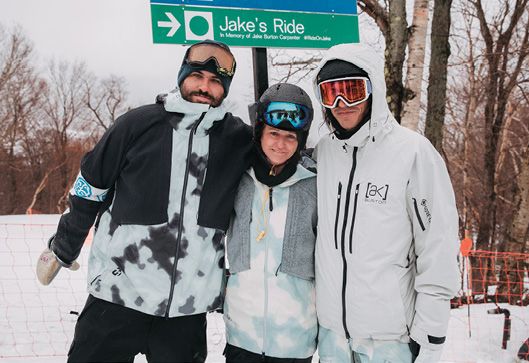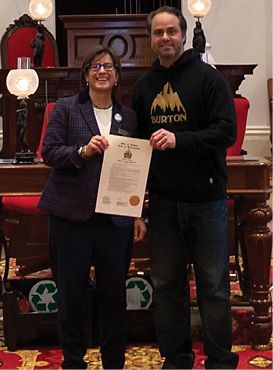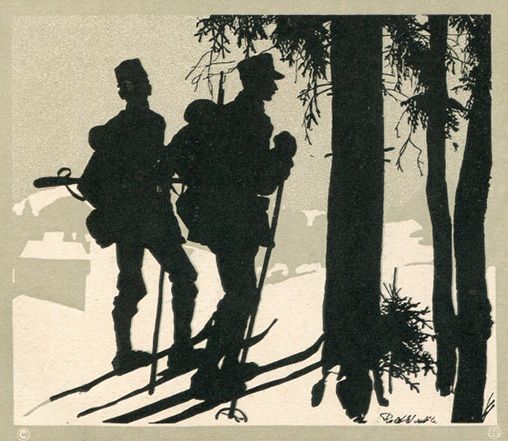
SKIING HISTORY
Editor Kathleen James
Art Director Edna Baker
Contributing Editor Greg Ditrinco
ISHA Website Editor Seth Masia
Editorial Board
Seth Masia, John Allen, Andy Bigford, John Caldwell, Jeremy Davis, Kirby Gilbert, Paul Hooge, Jeff Leich, Bob Soden, Ingrid Wicken
Founding Editors
Morten Lund, Glenn Parkinson
To preserve skiing history and to increase awareness of the sport’s heritage
ISHA Founder
Mason Beekley, 1927–2001
ISHA Board of Directors
Seth Masia, President
Wini Jones, Vice President
Jeff Blumenfeld, Vice President
John McMurtry, Vice President
Chan Morgan, Treasurer
Einar Sunde, Secretary
Richard Allen, Skip Beitzel, Michael Calderone, Christin Cooper, Art Currier, Dick Cutler, Chris Diamond, Mike Hundert, David Ingemie, Rick Moulton, Wilbur Rice, Charles Sanders, Bob Soden (Canada)
Presidential Circle
Christin Cooper, Billy Kidd, Jean-Claude Killy, Bode Miller, Doug Pfeiffer, Penny Pitou, Nancy Greene Raine
Business & Events Manager
Kathe Dillmann
P.O. Box 1064
Manchester Center VT 05255
(802) 362-1667
kathe@skiinghistory.org
Membership Services
Laurie Glover
(802) 375-1105
laurie@skiinghistory.org
Corporate Sponsorships
Peter Kirkpatrick
(541) 944-3095
peterk10950@gmail.com
Bimonthly journal and official publication of the International Skiing History Association (ISHA)
Partners: U.S. Ski and Snowboard Hall of Fame | Canadian Ski Museum and Hall of Fame
Alf Engen Ski Museum | North American Snowsports Journalists Association | Swiss Academic Ski Club
Skiing History (USPS No. 16-201, ISSN: 23293659) is published bimonthly by the International Skiing History Association, P.O. Box 1064, Manchester Center, VT 05255.
Periodicals postage paid at Manchester Center, VT and at additional mailing offices. Postmaster: Send address changes to ISHA, P.O. Box 1064, Manchester Center, VT 05255
ISHA is a 501(c)(3) public charity. EIN: 06-1347398
Written permission from the editor is required to reproduce, in any manner, the contents of Skiing History, either in full or in part.
Short Turns: Pro Tour, Jake Burton memorial, Ski art
World Pro Ski Tour draws star athletes but suffers short season due to COVID-19.
The World Pro Ski Tour never got to the meat of its season, which would have seen seven-time gold medalist Ted Ligety contending with silver-and-bronze Olympian Andrew Weibrecht for $150,000 in championship prize money.
Before the pro season was canceled, Ligety, at age 35, did break away from the World Cup season to compete in two Pro Tour races at Steamboat’s Howelsen Hill and Eldora. He had trouble learning to time the barn-door starting gates and his best finish was a fourth place at Steamboat—proving, he said, that the Tour was serious competition.
The Tour entered its third season with six events scheduled. A long list of sponsors, led by Tito’s Handmade Vodka, offered $300,000 in prize money. When COVID-19 canceled the final three events, Rob Cone of Killington and Middlebury College, a former NCAA champ and U.S. Ski Team Europa Cup racer, topped the field of 21 racers who finished in the money, winning $30,200 for the truncated season. Michael Ankeny, of Buck Hill and Dartmouth College, a veteran of eight years on the U.S. Ski Team, came second ($12,200). Garrett Driller of Squaw Valley and Montana State, an NCAA All American and U.S. Alpine Championship parallel slalom winner, finished third ($8,350).
The Tour Finals at Sunday River and the World Pro Championships at Taos were scheduled for April, after the close of the World Cup and national championships. Ligety and Weinbrecht were on the schedule to compete at those races. “To succeed, the tour needs those top athletes,” said tour chief Jon Franklin, who earned his chops managing top skiers for International Marketing Group. Because the Taos championship event would have awarded $150,000 in prize money, the participation of FIS superstars might have upended the full-season leaderboard. All the events were televised by CBS Sports Network (see season highlights at https://worldproskitour.com/multimedia/).
Franklin predicts a longer, richer tour for the 2020-2021 season. “We don’t have a schedule yet because it has to fit around the NorAm and World Cup schedules,” he points out. He hopes to open the season before the Beaver Creek World Cup in November.
Pro skiing has always depended on the star power of World Cup racers, beginning when Bob Beattie’s new World Pro Skiing circuit recruited the likes of Jean-Claude Killy and Billy Kidd. Fifty years ago, in 1970, Kidd won the FIS World Championship combined gold medal, promptly turned pro and then won the WPS championship the same season. He’s still the only skier to pull that one off. —Seth Masia

attended “A Day for Jake” on March 13 at Stowe, Vermont,
with his sons Taylor (left) and Timi (right).
Photo: Jesse Dawson/Burton
A Day for Jake
On March 13, snowboarders around the world took a ceremonial run to honor the late Jake Burton Carpenter —pioneer, innovator and entrepreneur—who died last November of testicular cancer. Though the global “Day for Jake” took some serious hits, most notably from the novel coronavirus and nasty weather, the event still came off at about a dozen resorts, from Avoriaz (France) to Boyne Mountain (Michigan), Big Sky (Montana) and Copper Mountain (Colorado).

Rep. Kathleen James in the statehouse
in Montpelier with Jeff Boliba, a Burton
vice president. A first-term legislator,
James sponsored a resolution honoring
Jake that won unanimous approval from
all 180 of Vermont’s senators and
representatives.
Jake’s wife and business partner, Donna Carpenter, and his sons George, Taylor and Timi, attended the festivities at Stowe, Vermont. A gentle beginner’s trail, Lullaby Lane, was renamed “Jake’s Ride” and Jeff Boliba, Burton’s vice president of global resorts, read a Vermont General Assembly resolution honoring Jake for his role in pioneering and promoting the sport. Just a few days earlier, Boliba had dropped by the statehouse to meet Rep. Kathleen James, a first-term legislator and the editor of Skiing History. James sponsored the resolution, which received unanimous approval from all 180 of Vermont’s Representatives and Senators.
Burton Snowboards then quickly turned its attention to the COVID-19 response, delivering more than 200,000 KN-95 masks to hospitals across Vermont and to Dartmouth-Hitchcock Medical Center, just across the border in New Hampshire. ISHA has launched a digital archive project to document how the ski industry is responding to the pandemic; see page 26.
Looking for Vintage Ski Books?
The word ski is derived from the Old Norse word skið, which means “snow-shoe” and “billet of cleft wood.” It first appeared in print English in 1755, in Volume 12 of The Monthly Review of London, an English periodical.

courtesy M. Michael Brady
With such deep linguistic roots, it’s no surprise Norway is a key source of vintage ski history books. And one of the country’s top shops is Ruuds Antikvariat on Ullevålsveien, a busy north-south artery in Oslo. From the Latin antiquarius, also the root of the word “antique,” Antikvariat means “vintage bookseller” in Norwegian.
The shop was founded in 1972 by Jon Ruud and is now managed by his daughter, Vibeke Ruud. Its glass display cases and shelves include such ski-history classics as Farthest North by polar explorer Fridtjof Nansen (1861–1930), with its many drawings of skiing, then called “snow-shoeing” in English. Another hallmark is Voyage picturesque aux alpes norvégennes (Pictorial Journey Through the Norwegian Alps) of 1821 by Finnish-Swedish military officer and cartographer Wilhelm Maximilian Carpelan (1787–1831), among the first to survey and describe the interior of the country.
Bibliophilism is a cherished part of Scandinavian culture, reflected in the presence of no less than 72 antiquarian and used bookshops in Denmark, Finland, Norway and Sweden. They’re all interconnected in an online network, where you can search more than 1.5 million titles in English, Danish, Norwegian and Swedish (https://www.antikvariat.net/en/?currency=USD). To learn more, go to: https://ilab.org/booksellers/ruuds-antikvariat. —M. Michael Brady
Typo Makes Trump Into X-C Skier
As a leading journal of skiing’s historical record, we feel compelled to correct an error noticed by an eagle-eyed Skiing History correspondent.
Not known as a fitness buff in this COVID-19 time or any other era, U.S. President Donald Trump was recently described (incorrectly) as a Nordic destination skier. On May 9, 2020, Positively Scottish carried the headline “IVANKA TRUMP’S PERSONAL ASSISTANT TESTED POSITIVE FOR CORONAVIRUS, ACCORDING TO A CNN SOURCE.” Included in the text was the startling statement that, “The day after breaking his self-isolation of the White House for a cross-country skiing trip intended to report the country’s willingness to start again, Trump received the news one of his Oval Office waiters tested positive for the virus.” While the route may have been cross-country, ski gear was not involved. —Jonathan Wiesel

Mount Ascutney Adds T-Bar
Mount Ascutney, a former major ski resort in southern Vermont, operated from 1946 to 2011. Generations of skiers learned to ski at this family-friendly area and were sad to see it become a “lost” ski area. But it wasn’t lost for long.
Several years after it closed, the nonprofit group Ascutney Outdoors worked hard to reopen a few trails, served by a brand-new rope tow in 2016. This past season featured the opening of a refurbished T-bar, expanding the lift-served vertical to just over 400 feet and 10 trails. The upper slopes, under a conservation easement, are maintained as hike-to terrain for those who earn their turns. The lower slopes also host a tubing facility, and an Outdoor Center serves as a hub for skiers, hikers, mountain bikers and community events.
Purchased from Le Relais, a ski area just outside of Quebec City, the T-bar was donated by Glenn and Shelley Seward in 2017 in preparation for future installation. Over the next two years, a fundraising campaign collected enough money for the T-bar to be installed at the end of 2019 and fired up in February 2020.
Ascutney’s humble beginnings are similar to many Vermont resorts. It was founded in 1946 as a rope-tow area by investors Bob Bishop, Catharine “Kip” Cushman, Robert Hammond, Bob Ely, Dr. Peter Patch and Dick Springer. Over the next six decades, the area went through many ownership changes, experiencing financial setbacks but also expansions, including a large hotel in the mid 1980s and a high-speed quad to the summit in 2000. Mounting fiscal problems led to its closure in 2011, and the ski area assets were sold off bit by bit.
Mount Ascutney is now a shining example of a new paradigm for smaller ski areas throughout New England that had financial difficulties or closed. Strong volunteer support, generous donations, and operating as a nonprofit can help these areas to succeed where prior operating attempts have failed. Loyal skiers have refused to let their favorite mountains fall by the wayside and are doing whatever they can to save special places like Ascutney.
Just ask Glenn Seward: “Those of us who love Ascutney don’t give up easily.” For more information, go to www.ascutneyoutdoors.org. —Jeremy Davis 
Snapshots in Time
1959 TAKE IT FROM THE TOP
1967 THE GREAT DEBATE: HOW LONG SHOULD YOUR SKIS BE?
There is no question today that the problem of the right ski length for the skier has become more and more vexing. Some people claim the best ski is a two-and-a-half footer for beginners, while others say the ski should be as tall as the beginner. Still others stick with the tried-and-true “hand high over the head” rule for every skier. Experiments and trends of recent years have warmed the air with questions: Both Head and Hart, following the lead of Clif Taylor’s Short-ee skis, have had great success with expensive five-foot skis … and last year, Karl Pfeiifer’s school at Killington introduced the Graduated Length Method that proved to be resoundingly popular at Killington and elsewhere. —Morten Lund, “Golden Rule for Ski Length” (SKI, September 1967)
1968 THE WAY IT’LL BE ON TV
In the four years since Innsbruck, television technology has advanced to the point where you will be able to see the dramatic opening ceremonies for the 1968 Winter Olympics live and in color at 11 o’clock in the morning EST and the Alpine skiing events in prime evening time, soon after they actually take place. And the use of split-screen technique at Grenoble will enable viewers to see the tenths of seconds that determine the gold, silver or bronze medals. For instance, if Jean-Claude Killy has competed his final run and is leading in the slalom, we can show Billy Kidd’s run live, with his time running against the time he needs to beat Killy. … The Winter Olympics will be one of the most challenging undertakings we’ve ever assumed at ABC Sports. —Roone Arledge, Vice President, ABC Sports (SKI, February 1968)
1978 WINTER PARK’S MIDDLE EAST CRISIS
George Haddad and entourage came to Winter Park last January for a celebrity pro-am event in a van bearing Minnesota license plates. When the fun-filled weekend was over, a cadre of red-faced officials and press found themselves the victims of one of the neatest little scams since The Sting.
Attired in authentic flowing robe, burnoose and a pair of vintage leather ski boots, Lebanese “oil sheik” Saleim Abdul Haddad hit the slopes and quickly stole the cameras. Photos were submitted to AP and UPI, and the sheik’s inimitable racing style graced the pages of papers from coast to coast. It wasn’t until an alert reader of a Duluth, Minnesota newspaper noted a striking resemblance between the sheik and George Haddad, fun-loving owner of a local shoe store, that the hoax came to light — and the sand hit the fan. —Ski Life (SKI, October 1978)
1989 PUTTING SKIERS TOGETHER
Mingling is a way of life at the Bark Eater, a 150-year-old farmhouse inn nestled in the Adirondack Mountains of upstate New York. Proprietor Joe Pete Wilson brings skiers together at a china- and linen-covered table for family-style dining every evening, seating guests into conversational groups based on personality. On those nights when the chemistry is right dinner can become a late-night affair, ending in a story-swapping marathon.
Joe Pete figures he has about 200 stories in his head, containing humor that ranges from “clean to dirty.” “We spend quality time with a small number of skiers,” he says. “I’d rather have 10 people and make sure they have a good time than 30 people who come and float away, never to be seen again.” —BOB LAMARCHE (SNOW COUNTRY, FEBRUARY 1989)
SKI ART

emerging from the woods.
Rolf Winkler (1884–1942)
The solid shape of any silhouette is what gives the image its power. In the mid-18th century, Louis XV’s finance minister, Étienne de Silhouette, levied a wealth tax on the citizens of France. This brought ignominy upon him; he was mocked and associated with cheapness. In the art world, a quick outline became known as a drawing à la silhouette.
At the time, portraits were painted, and therefore only those who could afford to sit for an artist were portrayed. But some artists had the ability to cut the profile of a person: These “silhouettes” were both quick and cheap and therefore, before photography, increasingly popular with the middle classes. And the cutting was done extremely quickly—for example, if you were visiting a country fair and happened on an artist with scissors in hand. One of the most well-known of these artists used to advertise “three-minute sittings.”
With the development of photography in the mid- to late-19th century, the call for silhouettes declined. However, in the early 20th century, probably inspired by the Arts and Crafts Movement, silhouette artists became extremely popular as they seemed to portray, in a curiously old-fashioned and nostalgic way, a treasured past. Nowhere was this more obvious than during World War I, as displayed here: These troopers are emerging from the woods and heading for the village below, just as they would have done in peaceful years.
Rolf Winkler, born in Vienna in 1884, was a painter, illustrator and silhouette artist. He studied at the Landeskunstschule (State Art School) in Graz, Austria, and later he spent time in Dachau, Germany in a vibrant art colony under the leadership of Ludwig Dill and Adolf Hölzel, landscape painters who were embracing modern trends. Dill was a founding member of the Munich Secession. Winkler settled in Munich in 1905 and over the decades illustrated over 400 books, mostly for juveniles. He also worked for the satiric weekly, Fliegende Blätter (Flying Pages). The illustration here is entitled “Skipatrouille” and was published by Teubner in Leipzig. This extraordinary publishing house specialized in Greek and Roman texts, mathematics and the sciences, and yet here in 1915 is Winkler’s “Ski Patrol,” one of six silhouettes contained in a special folder. Maybe this was their way of supporting the war effort. —E. John B. Allen

Table of Contents
2020 Corporate Sponsors

World Championship
($3,000 and up)
Alyeska Resort
Gorsuch
Intuition Sports, Inc.
Obermeyer
Polartec
Warren and Laurie Miller
Snowsports Merchandising Corporation
World Cup ($1,000)
Active Interest Media | SKI & Skiing
Aspen Skiing Company
BEWI Productions
Bogner
Boyne Resorts
Country Ski & Sport
Dale of Norway
Darn Tough Vermont
Descente North America
Dynastar | Lange | Look
Fairbank Group: Bromley, Cranmore, Jiminy Peak
Fera International
Gordini USA Inc. | Kombi LTD
HEAD Wintersports
Hickory & Tweed Ski Shop
Mammoth Mountain
Marker-Völkl USA
National Ski Areas Association (NSAA)
Outdoor Retailer
POWDR Adventure Lifestyle Corp.
Rossignol
Ski Area Management
Sun Valley Resort
Vintage Ski World
World Cup Supply, Inc.
Gold ($700)
Race Place | BEAST Tuning Tools
The Ski Company (Rochester, NY)
Thule
Silver ($500)
Alta Ski Area
Clic Goggles
Dalbello Sports
Deer Valley
Ecosign Mountain Resort Planners
Hertel Ski Wax
Holiday Valley
Hotronic USA, Inc. | Wintersteiger
MasterFit Enterprises
Metropolitan New York Ski Council
Mt. Bachelor
NILS, Inc.
Portland Woolen Mills
Russell Mace Vacation Homes
Schoeller Textile USA
Scott Sports
Seirus Innovations
SeniorsSkiing.com
Ski Utah
Snow Time, Inc.
Sports Specialists, LTD
SympaTex
Tecnica Group USA
Timberline Lodge & Ski Area
Trapp Family Lodge
Vuarnet
Western Winter Sports Reps Association
World Pro Ski Tour
For information, contact: Peter Kirkpatrick | 541.944.3095 | peterk10950@gmail.com
ISHA deeply appreciates your generous support!


